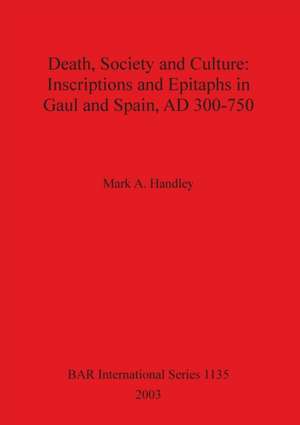Death, Society and Culture: Inscriptions and Epitaphs in Gaul and Spain, Ad 300-750: BAR International, cartea 1135
Autor Mark A. Handleyen Limba Engleză Paperback – 31 mai 2003
Din seria BAR International
-
 Preț: 161.24 lei
Preț: 161.24 lei -
 Preț: 250.80 lei
Preț: 250.80 lei -
 Preț: 358.33 lei
Preț: 358.33 lei -
 Preț: 312.77 lei
Preț: 312.77 lei - 8%
 Preț: 378.47 lei
Preț: 378.47 lei - 9%
 Preț: 630.23 lei
Preț: 630.23 lei -
 Preț: 238.41 lei
Preț: 238.41 lei -
 Preț: 312.44 lei
Preț: 312.44 lei -
 Preț: 404.57 lei
Preț: 404.57 lei -
 Preț: 358.19 lei
Preț: 358.19 lei -
 Preț: 280.62 lei
Preț: 280.62 lei - 9%
 Preț: 759.74 lei
Preț: 759.74 lei -
 Preț: 398.31 lei
Preț: 398.31 lei -
 Preț: 324.72 lei
Preț: 324.72 lei - 8%
 Preț: 499.33 lei
Preț: 499.33 lei - 8%
 Preț: 653.22 lei
Preț: 653.22 lei - 8%
 Preț: 614.40 lei
Preț: 614.40 lei - 8%
 Preț: 509.83 lei
Preț: 509.83 lei - 8%
 Preț: 608.03 lei
Preț: 608.03 lei - 8%
 Preț: 620.35 lei
Preț: 620.35 lei - 8%
 Preț: 613.25 lei
Preț: 613.25 lei - 8%
 Preț: 523.15 lei
Preț: 523.15 lei - 8%
 Preț: 690.87 lei
Preț: 690.87 lei -
 Preț: 348.85 lei
Preț: 348.85 lei - 8%
 Preț: 525.44 lei
Preț: 525.44 lei - 8%
 Preț: 595.97 lei
Preț: 595.97 lei -
 Preț: 301.86 lei
Preț: 301.86 lei - 8%
 Preț: 456.90 lei
Preț: 456.90 lei - 8%
 Preț: 653.06 lei
Preț: 653.06 lei -
 Preț: 329.14 lei
Preț: 329.14 lei -
 Preț: 429.73 lei
Preț: 429.73 lei - 8%
 Preț: 467.75 lei
Preț: 467.75 lei -
 Preț: 399.07 lei
Preț: 399.07 lei - 9%
 Preț: 758.06 lei
Preț: 758.06 lei -
 Preț: 313.90 lei
Preț: 313.90 lei - 9%
 Preț: 1144.93 lei
Preț: 1144.93 lei - 8%
 Preț: 656.78 lei
Preț: 656.78 lei - 8%
 Preț: 444.94 lei
Preț: 444.94 lei - 8%
 Preț: 577.02 lei
Preț: 577.02 lei - 8%
 Preț: 549.09 lei
Preț: 549.09 lei - 8%
 Preț: 642.36 lei
Preț: 642.36 lei - 8%
![Viking Age Amulets in Scandanavia and Western Europe: Site Catalogue [With CDROM]](https://i3.books-express.ro/bs/9781407307138/viking-age-amulets-in-scandanavia-and-western-europe.jpg) Preț: 538.73 lei
Preț: 538.73 lei - 8%
 Preț: 442.84 lei
Preț: 442.84 lei - 9%
 Preț: 808.49 lei
Preț: 808.49 lei - 9%
 Preț: 889.53 lei
Preț: 889.53 lei - 8%
 Preț: 605.59 lei
Preț: 605.59 lei -
 Preț: 430.33 lei
Preț: 430.33 lei -
 Preț: 413.51 lei
Preț: 413.51 lei - 8%
 Preț: 454.04 lei
Preț: 454.04 lei -
 Preț: 415.04 lei
Preț: 415.04 lei
Preț: 602.23 lei
Preț vechi: 654.59 lei
-8% Nou
Puncte Express: 903
Preț estimativ în valută:
115.27€ • 125.25$ • 96.89£
115.27€ • 125.25$ • 96.89£
Carte tipărită la comandă
Livrare economică 21 aprilie-05 mai
Preluare comenzi: 021 569.72.76
Specificații
ISBN-13: 9781841715087
ISBN-10: 1841715085
Pagini: 244
Greutate: 0.84 kg
Editura: British Archaeological Reports
Seria BAR International
ISBN-10: 1841715085
Pagini: 244
Greutate: 0.84 kg
Editura: British Archaeological Reports
Seria BAR International
Notă biografică
Mark A. Handley
